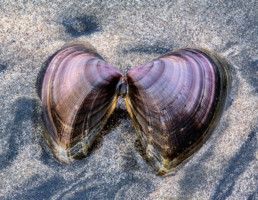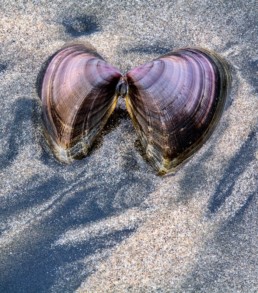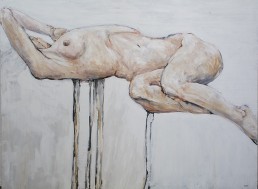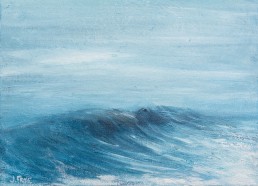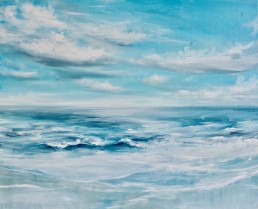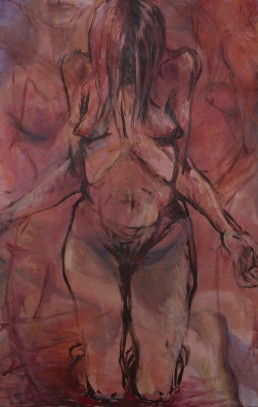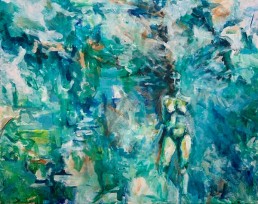In Memoriam, Mary Oliver
Mary Oliver made a sacred practice of her direct sensory experiences, her intimate bodily connection to her place and days. And then she did the hard work of crafting some altered but analogous version of those experiences, rendered through lines on a page. She made us feel what she sensed. Then, at least for her dedicated students, she inspired us to go out and be passionately sensory in our own bodies, to make sense of the world for ourselves.
This morning I carried my surfboard across the sand towards the water as the sun came up on the other side of the hill behind me. It’s one of an arc of foothills ringing this white-sand Costa Rican beach set deep in the jungle. As I walked, I looked out to one of my dear friends, L, already in the water. I am often aware of the difference between us. She’s significantly younger and, at this point, stronger than I am. She’s German and speaks English, thereby allowing our friendship. I’m American and (despite a LOT of Spanish DuoLingo) still just speak English. She’s one of the few people I know who loves to share waves with friends as much as I do. I treasure every session we have together. The walk to surf is always thrilling and often at least a little bit scary. Heading out to ride waves with loved ones adds a primal tribal thrill to the experience. We are here. Today, the instant the first wave ran over my feet, the sun crested the mountain and L was suddenly bathed in intense warm light. Now there were two of her, one whole, embodied version and another, equally clear and colorful liquified reflection undulating, spreading, and shrinking in chaotic lyrical patterns on the water beneath her. I remained in shadow of the mountain as I walked deeper into the water. For a few delicious seconds, with someone I love out there, in another world but deeply connected, her fleeting moment in light and mine in shadow helped me sense something about life and death, about love and age and loss and, above all, about beauty.
John O’ Donohue said that in the presence of beauty we feel more alive. Beauty, he said, is quickening, not deadening. If he was right (and I believe he was), then Mary Oliver was among the truly beautiful humans of my era. I suspect I might have said that was true before last week, but the collective pain and celebration of her death lent texture to that truth. She made so many of us feel more alive. She wielded what looks to me like a powerful sort of magic. She made a sacred practice of her direct sensory experiences, her intimate bodily connection to her place and days. And then she did the hard work of crafting some altered but analogous version of those experiences, rendered through lines on a page. She made us feel what she sensed. Then, at least for her dedicated students, she inspired us to go out and be passionately sensory in our own bodies, to make sense of the world for ourselves.
She communicated her amazement, her knowledge of how to pay attention, through plain language, alchemically transformed into powerful incantations that conjured a world fully populated by sensuous others, this grasshopper and those wild geese, a hungry bear and swollen blackberries. Each seemed to enter our brains in numinous phrases that, in turn, filled our bodies with something so potent that those lines could shift a day. With enough reads, they could shift a life. An intensely private person, she worked in a way that built a community broader and deeper than I’d known before last week. Her power turned the understandable, hopeless, endless streams of social media outrage at the outrageous into a moment of collective pain with beauty, not vitriol and fear, at its center. Despite a difficult childhood, her work never, not once, indulged in self-pity.
I don’t believe the thought ever occurred to me, that Mary Oliver was going to someday die. This week, the week she left us, I’ve been thinking about little else. There is Upstream, which I devoured and revisited like a brilliant, new, love-at-first sight friend. And those last books and poems, many of which I’ve not yet read— she might have died before having gotten to those. So, in addition to an unexpectedly profound grief, I am swimming in gratitude for her. I clearly failed to recognize my own attachment to her as a living being. I began writing this, the week she sensed her last day, surprised to find myself falling into grief. After all, most of the writers I love are dead. I never met Mary Oliver. She almost never gave interviews and I knew almost nothing about her life except that she made a habit of walking early with paper and pen, courageously built a life with the women she loved, taught college writers for awhile, and had an almost eerie capacity to write what I most needed to read. I only heard her for the first time a few years ago, when she released a cd of readings, called On Blackwater Pond. By then her voice was that of a much older woman than almost all publicly available photographs of her, except the often reprinted portrait of her as a youngster, the one taken by her partner of decades Molly Malone Cook. The few Mary’s I’d seen, young, suddenly middle-aged, then old, punctuated the fact that her life had occurred somewhere hidden. Meanwhile her sometimes denigrated work poured out into the public that I felt fortunate to be a part of. I didn’t know her and still have just as much of her as I ever did. I have her lines on a page. And yet, here I am, grief-stricken.
A few days after she left us, there was a total lunar eclipse— a Blood Moon. I watched the eclipse near midnight, lying with L and many strangers on a dark, windy beach in the northwest of Costa Rica. Like Oliver’s death, the eclipse was a surprisingly emotional experience. I have seen several but they never fail to move me. Despite thinking I’m ready, I always go in unprepared, and come out surprised. Last week I lay on that beach, pelted by fine grain sand working its way into every orifice, looking up through the binoculars provided by a well-prepared German I’d never met and couldn’t recognize now (“Fernglass, anyone?”)
I watched as the eclipse turned “total.” The moon was red with the thinnest leftover losenge of reflected white daylight on its left side, like an opening parenthesis promising a useful aside. I lay there open, in a way I’ve long practiced, ready to sense and learn something. I owe that sort of receptivity in large part to Mary Oliver. And learn I did. I could, in that instant, finally feel why each eclipse is so affecting and maybe Oliver’s death too- similarity across scale.
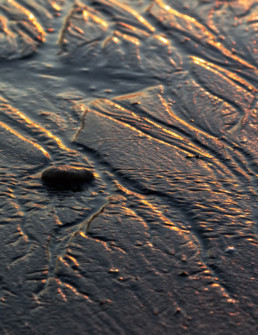
Fractals are … are nearly everywhere you look in nature and even in those organs doing the looking (the wild, spherical landscape of your eyeball). Coastlines and clouds are fractals and so are trees and your circulatory system. A tree is a fractal because the trunk, branches and leaf veins continually repeat the pattern of dividing into smaller and smaller, self-similar shapes. Your circulatory system is also a fractal. Your aorta is fat then branches off repeatedly into thinner and thinner vessels as the recursive pattern (and nourishment it allows) reach towards the edges of your body.
There’s a shape in mathematics (stay with me here!) called a “fractal.” We all know many fractals, and have known them for far longer than there has been an English word or any math attached to them.
The fractal foundation defines fractals as
infinitely complex patterns that are self-similar across different scales. They are created by repeating a simple process over and over… Driven by recursion, fractals are images of dynamic systems – the pictures of Chaos.*
Fractals are complicated (even chaotic) patterns arising from simple, repeating processes. They are nearly everywhere you look in nature and even in those organs doing the looking (the wild, spherical landscape of your eyeball). Coastlines and clouds are fractals and so are trees and your circulatory system. A tree is a fractal because the trunk, branches and leaf veins continually repeat the pattern of dividing into smaller and smaller, self-similar shapes. Your circulatory system is also a fractal. Your aorta is fat then branches off repeatedly into thinner and thinner vessels as the recursive pattern (and nourishment it allows) reach towards the edges of your body.
I only learned what fractals were after becoming obsessed with them as a photographic subject. I knew that that recursive shape was beautiful, that it looked like life. It made perfect sense when I finally learned a little about the geometry. And it didn’t just do so in the intellectual way but as David Abram says, things that make sense enliven the senses. That night, for one of the first times in my life, watching that eclipse, I could feel the math. I could sense similarity across a vast difference in scale. My pounding heart joined the percussive chorus of pelting sand and the distant mathematical music of those spheres (sun and moon) working with the earth, supporting me as it put on this show. It was revelatory that the earth, a body larger than my own tiny mind can imagine, was moving through light and casting a shadow just like my body does. I could see it happening. In that moment it was hard to not feel like a part of the whole, a small, sensing section of the cosmos with just as much right to cast a shadow as the earth itself, just as much freedom to be carried by wind as the sand. With my heart opened by sadness and quickened by beauty it was possible to feel like, in my own humble way, perhaps on scale difference about on par with the difference between my body and the earth’s, I have been making my own kind of Oliverian beauty. I have been living “one wild and precious life” spent as “a bridegroom taking the world into my arms.” Mary Oliver had, in her work, given me permission and guidance to take the million steps that got me to that beach, looking through a generous stranger’s fernglass. Because of Mary Oliver, I felt free. After a lot of doubt and many wrestling matches with shame, I felt free to accept that this precise sort of experience as the foundation of my work in the world. Rooting intellectual and spiritual learning in the sensuous world is at the root of the most powerful form of service I can offer others.
But in the years before I knew her poetry, it sure didn’t feel that way. By any measure, as a child and adolescent I would have been diagnosed with attention deficit disorder (had it been available, or my mother capable of entertaining for a fleeting moment that there might be anything disordered (as opposed to extraordinary) about me. Equally intolerant of disapproval, sitting, or being told what to do, I spent my early adulthood mostly going through the motions of my formal education. When freed from that, I wandered around what I was pretty sure were enchanted woods near my North Carolina home, splashing through creeks that felt like friends. When I got a little older, I added taking pictures to the journeys, so that even when I was in I could relive the reverie of being out.
I taught myself the technical aspects of film and darkroom photography through a series of three books Ansel Adams wrote. I spent time every single day staring at reproductions much more lavish than anything I could then make in the darkroom. I devoured biographies of the great modernist photographers I admired, Imogen Cunningham, Edward and Brett Weston, Ruth Bernhard, and Tina Modotti. Their stories of visible achievements earned by their own traipsing with cameras, slaving over prints and, most of all, finding teachers, guides, sometimes one another to help them develop their skills and vision, infected me with a ravenous hunger for a mentor who might help me figure out my confusing life. I spent years searching feverishly for a guide, an older person who was out there doing what most people I knew probably characterized as wasting time, exploring the natural world without an agenda of expertise. And then, later, crafting beauty. I wanted a guide who spent her life staring, trying to really see already beloved places, to know them fully in some carnal, intimate way. That, after all, was how I’ve lived most of my life as a photographer. I was pretty sure everyone I knew must be judging me harshly for it. The self torture was senseless— I was too young to know no one really cared what the hell I was doing with my time.
And I really didn’t have any choice about how I went about that work anyway. Only after I felt the flower, the creek, the rock, the wave had somehow entered me, that the subject had allowed me some sort of communion, only then did I feel it was polite to get the camera out and make something I could take away and show others. Although all that seemed like a childish habit to hide, to be ashamed of, in my early 20s, I knew I had no choice but to be out there doing just that. If I’d not been afflicted by a bad case of needing to be a good girl, I might have rebelled outright but I was looking for a work-around and permission from someone in authority. I was entitled enough to feel like I should be able to be unconventional with approval. I wanted an elder human whose life looked at least remotely livable who I could ask the hardest questions and who might give me some indication that they understood and cared what the hell I was talking about, that it all mattered, that I was okay and just needed to keep working. I never found that person in the flesh and spent too much time feeling either terrified or sorry for myself for about a decade.
Then, somewhere along the way, I was given a copy of New and Selected Poems by Mary Oliver. It came out in 1992, right about the time I became a full-time professional photographer. I’d been an English major and had read plenty of poems, plenty of nature writing. I had (and still have) a dogeared Walden that I carried around with me nearly everywhere. But I had never been schooled by another human like I was in the time I’ve spent with Mary Oliver. She taught me that the precise sort of hyper-focus on what was most mesmerizing and the desire to fall passionately in love with the most minute parts of place (specimens, some might call them) was not a disorder, or didn’t have to be. It could be the foundation of making, or entering something beautiful. Her arresting, deceptively simple writing made me see that if you worked on making something out of what you learned in the heat of the passion that characterized those experiences, you could create a life that could be quickening, not deadening. And, if you found ways to repeat the tiny, sacred patterns on larger scale as you went, perhaps the beauty you made would not just be for you but for someone else, maybe even several someones else.
In short, Mary Oliver helped me get over myself and focus on creating meaning out of the magic of being alive. Over the next few years living with her lines as part of my days, I came to understand what has become one of the guiding principles of my own life. Inspiration is sacred and, metaphorically, a calling. The power of the planet as a whole and of the human-scale habitat we occupy, the gravity and fluids and fractals that give our beleaguered, paved-over, cut down world and our own bodies their multiplicitous shapes, that power deserves our focus. And, regardless of the source of your inspiration, if you can find ways to translate your focus, your joy, and love into a substantial offering, if you can somehow recognize your gifts, whatever those happen to be, and augment them with skills so that you can someday serve someone else’s need for meaningful focus, for nourishing attention, for meaning, and beauty then you might even be better than okay.
Why hadn’t the other naturalists and nature writers I’d read, especially Henry David Thoreau, done that for me? That question has lodged in my head since Oliver’s death and I think the answer might be especially relevant to our current political, cultural, and environmental moment. Intellectually, his sort of dedicated observation seemed superficially similar to what I was

unconsciously cultivating as I tried to figure out how to be by walking through rivers and developing film, but it felt almost opposed. Thoreau, it seemed to me, was making an argument that wilderness was the solution to a human problem. I was not looking for wildness, which suggested some sort of insurmountable gulf of difference between me, a discontented product of civilization, and every other thing out in those woods. I was looking for (and finding) intimacy, connection and belonging, a means of ending, once and for all, a lonely isolation behind some barrier I just couldn’t shake no matter how good or easy or privileged my life was. I needed a dissolution instead of a solution.
There’s one line from Walden that I think might get at the heart of the difference between these two writers and, in turn, the difference between one way of many of us unthinkingly approach our lives and one another. Thoreau often wrote with a voice that emphasized his expertise and assuredness, and he had plenty of both! When he evoked the animal, sensing part of him, it was often in opposition to his humanity.
“I found in myself, and still find, an instinct toward a higher, or as it is named spiritual life, and another toward a rank and savage one, and I reverence them both. I love the wild not less than the good.”
Thoreau’s writing promised transcendence and a superior way to live, as opposed to all the poor saps in bigger houses with day jobs. Wilderness could save you. Don’t get me wrong, I loved what he wrote and even spent five years in a cabin in the woods with no bathroom, living out my own version of Walden.
But, in retrospect, I believe that the desire to achieve some kind of transcendence (and implicit superiority over all this business of every day life) and the agony of the certain knowledge that I was so flawed, so prone to inattention, and likely to fail at being an expert grown-up didn’t help me one bit. I knew enough to know that I didn’t just need abstract knowledge, that studying anything in disembodied form wouldn’t stop the fear or bring the connection. I grew up in a place where waiters were likely to about to have (if they didn’t already have) PhDs. I saw experts everywhere, but so few people living a life that looked all the way alive.
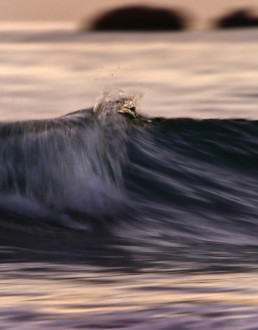
But Oliver wrote with such humility and a passionate, intimate continuity between what she was and what she sensed in the other. In poem after poem, she defied all my expectations about books and writing. She was never the world’s superior, often its supplicant. Just to pick one of many examples, in Luna, she wrote of her encounter with a moth, an individual possessing and fulfilling its purpose during a few short days and she felt no need to neatly order and classify it, to identify it as one of many Actias luna.
Of herself in this meeting with the moth she wrote
I live
in the open mindedness
of not knowing enough
about anything.
Seeing the moth dead “hurt her heart,… another small thing/ that doesn’t know much.”
And while Thoreau boasted about his life well-lived, time, for Oliver, often seemed scant. There was no amount of life in the woods that would save the lover from the grief of losing the beloved too soon.
Even the summer “also has its purposes/ and only so many precious hours.”
She saw value in grasshoppers, not just as specimens in a system (genus/species) like Thoreau had. Instead she was concerned with this grasshopper, the one she could touch, the one who also looked right back at her, with its own agency and the vision of “enormous and complicated eyes.”
In retrospect, that book of poetry I stumbled on in the 1990s turned Oliver into the mentor I was looking for. Her writing helped me dissolve that barrier I’d carried around since I was a teenager. As a result, I got a lot less lonely and self-absorbed and a lot more generous and receptive. With her help, wild and good became indistinguishable.
Later, when I unexpectedly fell passionately in love with teaching and I found myself playing the very role I’d never found anyone to fulfill for me, I realize the gift Oliver had given me was magnitudes of order greater than I’d thought. As desperate as I’d felt to find someone I could trust to tell me I was okay, I discovered the reason to find a mentor is not so you can be okay. That’s only a fraction of the story, one vein in the recursive pattern. Mentors allow you to develop the wherewithal to guide others, to show them that they are, in and of themselves, as okay as any mortal can be. That they can let the soft animal of their bodies love, that their life is, in fact precious, and that being idle and blessed (at least as Oliver clearly was) isn’t as easy as it sounds but that no thing is more worthwhile, especially if you can build from those moments some form of service or calling. As you help others find their place in the pattern, you create your own.
This month saw the death of a beautiful mentor, a guide, another human who loved and looked hard, who labored and lost and grieved and then transfigured all of that life into writing that reached so many of us. As dependent as I am on walking into and feeling water, on seeing light and shadow, on learning directly through my sensual existence, I can’t imagine the last 25 years without those poems. They helped me recognize that the deep attention demanded by love, in any form, of a friend, a partner, a moth, a wave, work, or play, is the most abundant, generous, exacting, and profound teacher we can learn from. I could repeat her lines like incantations, those patterns of observation, of passionate receptivity, and offer them to so many others who, in turn, could feel they were, flawed though they might be, a part of “the family of things.” LINK Over and over, the aortic abundance of Mary Oliver’s work gave me a pattern I could adapt and repeat. It lent dignity to the tiny branch of beauty I was working to create. She offered her life in service of the most disciplined, lovingly crafted version of her intimate moments and, in turn, offered me my own. Grief does seem the only human, the only beautiful response. As much as my thinking homo sapiens brain knows better, this was a month when it felt like the moon and earth, the sand and the shadows and the surf, all bowed their heads to acknowledge the loss.
If you’re interested in setting up a free, no-obligation conversation with Maia about coaching, mentoring, or a custom retreat, email her at maia@wavestowisdom.com.
- Check out Ron Eglash’s fascinating TED talk about fractals at the heart of African designs
Sharks, painting, and patience
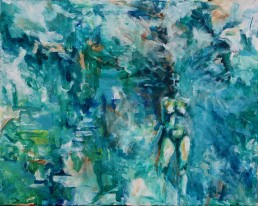
Joanna Frye, Untitled, 2017, Acrylic on Canvas
Sharks, Painting, and Patience
In our interview, artist and frequent ocean buddy Joanna Frye and I discussed the release from creative responsibility that comes with surfing. She said that when she surfed it felt like she was being painted instead of doing the painting. There is still plenty of creating going on when you surf or play in the ocean, it’s just not all coming out of your own limited human imagination and skillset. It’s not all dependent on your work. For those moments in the waves, you can’t even begin to lie to yourself about being in control of life, about dominating the world, or forcing an outcome. But you do, eventually, achieve some sense of control of your relationship to yourself and the uncontrollable.
Playfully, creatively tapping into a wider, deeper and, if you prefer, higher power is a practice that can, over time, change your mind and could do so, some neuroscientists think, by measurably changing your brain.
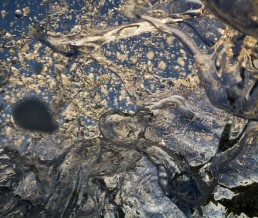
The research about the plasticity of our brains is thrilling but I don’t need a neuroscientist to tell me this: to catch a wave requires presence and acceptance: you can’t hurry things, or waste time thinking about the past or the future, or wish they were easier or more interesting. There just isn’t time for that. Not if you want to be there for that ride, to feel the rush and lift, and respond in whatever way your own body will allow, to be with that force for a delicious instant, to feel the joy of being on a planet with gravity instead of putting your creative energy into the futile task of working to somehow defy it.
One of the 20th Century philosophers I think is worth wrestling with is Maurice Merleau-Ponty. He wrote that “[t]rue philosophy consists of re-learning to look at the world.” It’s a pretty inclusive definition and seems to include those of us who are honest and brave enough to know that we need to revise our vision as we, our insights, and the world change. Merleau-Ponty’s work focused on that instant of perception, a sliver of time before our scientific, categorical mind can take over and begin to catalog, dismiss, prioritize, and judge. He thought this moment of perception was the beginning of all creativity, all art.
He wrote that “it is the expressive operation begun in the least perception, which amplifies into painting and art.” He also thought painters were uniquely well suited “amplifiers.”
Carolyne Quinn wrote a wonderful, accessible article about Merleau-Ponty’s work on perception and painting. Quinn writes that, for Merleau-Ponty “meaning is not found pre-existent in the world but is called into existence by the body’s own activity in the world.”
Merleau-Ponty’s work is more popular since his death than during his life because, as it turns out, his writing is more relevant to what we’re learning about our brains now than what we knew about them then. Think about it. If he’s even a little right, and we are dependent on our sensing bodies to help create meaning, what are our hyper-stimulated, scanning, swiping, fractured, and busy days doing, not just to our bodies, but to the meaning we call into existence in the world.
Quinn describes one of Merleau-Ponty’s most inspiring ideas, something called “reversibility.” Merleau-Ponty thought our body is both an entity that senses and an entity being sensed, and not just in the way your body is busy seeing and being seen by other partially dressed humanoids on the beach, but in the touch of a tree or a rock or a wave. You can be altered by the wave and the wave by you. Everyone who plays in the ocean knows this to be true. Merleau-Ponty just expands that intuitive understanding to encompass all perception. He thought that to understand either side of perception- being touched or touching, we needed to know they were not wholly separate, not either/or, and not one and the same. Instead, they overlap, both always part of any perception we have of the other. He thought most of us walk around with limited vision that ignores much of the rich, invisible depth of being sensed by the other. But not painters. According to Merleau-Ponty, while the rest of us (including photographers) couldn’t get at the real substance of perception, painters could render the invisible visible to the rest of us. Their paintings had the potential to render some of this fluid motion, this oscillation between seeing and being seen.
Because I live on the coast, because it’s the discipline at the center of my work and life, because it makes me feel sane, and is just too damn too beautiful to miss, I get in the ocean almost every day. A few weeks ago I hurt my rib in an unlucky fall and, while it’s been healing, I’ve been going in with my camera instead of my surfboard, photographing in the small, late summer waves each dawn and early morning. There are fewer black skimmers and the fish are starting to return in droves, each peaking shore break wave filled with dozens. My own species has begun its daily turtle walks. One one level, they’re out there looking for signs of nesting. But really, I think they are looking to call the meaning of hope into existence, walking with the hope that, for some perceiving moment in the future, they might dig a trench or hold a light that could help hatchlings, endangered as individuals and species, along their way. Even if they don’t save every turtle, they might save themselves.
Today, between sets of waves, a small shark swam from behind me, passing me on the right at a slow, leisurely pace— maybe there’s food aplenty. Rushing isn’t a priority. It must have seen me before I saw it, just so much inedible flotsam.The moment I saw its fin break the water, that instant of perception before I could categorize, the moment when my animal brain registered its size relative to mine (it was tiny, maybe 2 feet long), at its presence in the water, right there, with me, seeing me, and the resulting elation I felt at being seen (if it had been 2 meters long, I expect my perceptions might have been… different),— all reminded me of both Merleau-Ponty, and one of Joanna’s paintings that hangs on my wall, one that evokes something of immersion in liquid and light and motion, just like this morning. Reminding is a word we often say but don’t appreciate. To remind yourself is not just to recall, but to restore your mind to something valuable. I love that painting because it feels like the dissolution that happens to me in the ocean, the unimportant stresses and worries gradually losing concentration until they wind up just disappearing, and, even if they return, the wisdom and perspective that comes from the their intermittent disappearance endures.
Philosophers have been imploring us for a long time to learn to accept what we can’t change. The Stoics of Ancient Greece did it. Some Buddhists did (and do) it. The Serenity Prayer does it. But most of us still suck at it: quick to irritation or anger or a wish for a trap door into which you might dispense with or exchange the reality of the aggressive driver, the glitchy gadget, the broken rib- there are so many situations in our daily lives that regularly, reliably immerse us in stress, even when everything’s going “right.”
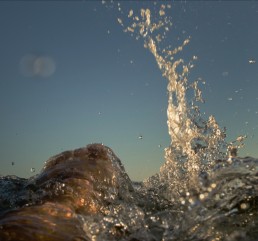
As soon as I realized my rib was well and truly hurt, that I might miss weeks of surfing these beautiful summer waves, I panicked. I didn’t want to miss waves. This was a disaster.
A minor one my brain scolded.
My feelings did not obey.
I began to focus on speed healing. Googling nutrition and bone injuries, stocking up on vegetables with Vitamin K (green cabbage has twice as much as red), doubling up on magnesium supplements, uncovering the miracle of comfrey (which is pretty miraculous). Maybe it was just a bad bruise and would be surfable in a few days?!? A couple of false starts over the next week helped me settle in. As a wise yoga teacher once told me, “If you get into a fight with your body, you are going to lose. Every. Single. Time.” Recovery would take exactly as long as it would take.
One of the primary, foundational motivations for this Waves to Wisdom project is finding ways to let others in on one of the central, grounding, and most useful working theories I’ve figured out in a long time spent figuring: our bodies and their perceptions are primary to what we create. What we experience when we are at play and deeply at home in our bodies, when these bodies we all have feel integrated into, even continuous with our larger home on the planet– these moments can be lessons that recast our lives; even the objects, people, and relationships that seem utterly familiar to us. We can perpetually see them anew and, in turn, be renewed in their eyes. The ocean is one particularly exciting and beautiful way to learn these lessons.
If, on the other hand, we spend all of our time scanning, slouching, and constricting, or dominating, forcing, and demanding, we can’t help but create meaning and methods to match. We value what will entertain or enrich us in our slouch instead of allowing ourselves the benefit of experiencing life elongated, expansive, fully oxygenated, and open to what’s right here and far away, open to the interdependence of self and other. We all sometimes allow the endless stream of information and news and wellness advice to overwhelm this moment, the only one we have, the one we don’t get back, the one in which someone nearby, a tree, a turtle, a neighbor, maybe even we ourselves, could benefit from some awareness of seeing and being seen.
That shark was today’s teacher and the painting it somehow called into my awareness the fortunate ongoing reminder of the lesson. I’ve been looking at it for a long time but I saw it anew today and it wasn’t anywhere in sight. I realized, without words, with the flick of the tip of undulating fin and tail, why I’ve loved it so much. That instant of sensing, of being sensed, being part of what Davis Abram calls “the biological matrix of life on the planet,” and being a person fortunate enough to return to walls and art and one painting in particular, was an exquisite episode of “reversibility.”
I owe that “unlucky” fall for the gift of this day sitting at my desk, rib healing, with the painting about as far away as the shark was, seeing me see it with reminded eyes.
For us too, if there’s enough food, maybe rushing doesn’t need to be a priority.
For information about retreats or to set up a free coaching session email maia@wavestowisdom.com.
Sources
Abram, David. “Merleau-Ponty and the Voice of the Earth.”Environmental Ethics, volume 10 (1988), pp. 101-120.
Cheron, Guy. “How to Measure the Psychological ‘Flow’? A Neuroscience Perspective.” Frontiers in Psychology 7 (2016): 1823. PMC. Web. 31 Aug. 2018.
“Maurice Merleau-Ponty (1908-1961)“. The Internet Encyclopedia of Philosophy
Staiger, Christiane. “Comfrey: A Clinical Overview.” Phytotherapy Research26.10 (2012): 1441–1448. PMC. Web. 31 Aug. 2018.
“Stoicism.” The Internet Encyclopedia of Philosophy
Quinn, Carolyne. “Perception and Painting in Merleau-Ponty’s Thought.” Paris III, Université de Sorbonne-Nouvelle/University College Dublin
Interview: Joanna Frye
To listen to the interview scroll to the media player at the bottom of the page.
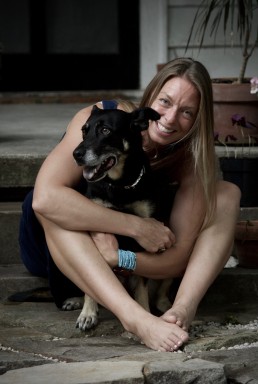
SHOW NOTES
Links also available in transcript.
Interview Transcript
Maia: My name is Maia Dery. This episode is part of a series called the Waves to Wisdom Interviews. The project is a simple one. I seek out people I admire— surfers, with what look to me to be ocean centered wisdom practices. I ask them if they’d be willing to share a surf session or two and then, after we’ve ridden some waves together, talk to me about their oceanic habits: about surfing, work, meaning, anything that comes up.
Joanna: Christians tend to isolate their spirituality from everything else. It happens on Sundays or in the early morning or some such and surfing, being in the ocean specifically, is like experience… experiencing God everywhere, all over, not just in my brain.
Joanna Frye is a visual artist and surfer who a few years ago decided to make a bold move. One of my favorite authors, Annie Dillard, once wrote
“How we spend our days is, of course, how we spend our lives. What we do with this hour, and that one, is what we are doing.”
Joanna wasn’t entirely happy with the shape of her hours so she left her day job to try to earn a living by selling her paintings and found object assemblages. She’s a devout Christian who loves to paint the female nude and now a dear friend from whom I’ve learned a great deal. Maybe, most important for me, I’ve gotten a long needed understanding of how much my fear has gotten in the way of my connecting with others who don’t think like I do.
Joanna played a crucial role in my own gradual, halting process of gradually overcoming a nearly lifelong fear of Christians, spurred on by the rhetoric of the the religious right combined with the fact that my own life turned out to be not so heterosexual.
If our interview gives you just a sliver of all I’ve learned from this courageous, talented, and creative woman, you’ll leave this interview with an abundant gift. Welcome to Waves to Wisdom.
Maia: If you are comfortable with it, tell us your name, age and how long you’ve been surfing.
Joanna: Okay. I’m Joanna Frye and 37. I’m not quite sure of the next answer— probably 12 years 10 years 12 years.
Maia: Ok, so you were grown up when you learned how to surf [I was a grown up]. Tell that story how did you decide you needed to learn that?
Joanna: I moved to California and had lived there for a year and was watching people surf and thought it was really cool and was sitting there and just thought why aren’t you doing it if you think it’s so cool? And I had friends that were in the surf industry working for Surfline and so they kind of, on a trip to Mexico to camp and they threw me on a longboard and pushed me into waves and that was that.
Maia: Did you love it from the very first time?
Joanna: From the very first time.
Maia: Did you catch a wave that first day?
Joanna: I did. I don’t know I if I stood up I don’t really have a memory except for being freezing. I had no wetsuit I was in a bathing suit in, near Ensenada freezing. I got hit in the head with the board, I remember that [Laugh].
Maia: OK, and then you came back to California and what happened next in your surfer story?
Joanna: Next, I spent, I had $155 in my bank account and I spent $150 on a 6’6” little thruster, cause I didn’t know better and that’s how it all began.
Maia: Wow. And how long did it take you to surf that thruster?
Joanna: Woo… that was a humbling experience but you know I didn’t know that. I just thought, I would stand beside it, I couldn’t sit on it, I would fall off. So I would stand beside it, wait for a wave to come, turn around get on and paddle. But I had a cohort, Marie, and so, and we were obsessed. And so we just went every day. I bought an 80s neon orange and black wetsuit from the thrift store that said, I don’t remember what, something across my rear, just ridiculous and had holes all in it but we went every day. And then I eventually was standing and I couldn’t think of anything better. Ah
Maia: And where were you living in California at that time?
Joanna: San Clemente
Maia: And you are from North Carolina, [yes] tell a little bit about that. Where are you are from and how did you get to California.
Maia: I’m from Kernersville, K Vegas , Kernersville, North Carolina, it’s a small sweet little town grew up classically with lovely parents and a sister and, you know, tended the garden and went to sports practices and eventually went to school at East Carolina and then after that did AmeriCorps so made my way to Texas and then Colorado and eventually California.
Maia: And had there been anything prior to surfing that was similar?
Joanna: No.
Maia: No? Surfing was unprecedented for you? [Yes] OK, it felt different?
Joanna: Um… yeah, it’s the only thing that I’ve ever had that I actively wanted to do all the time and checked in on to see if I could, constantly.
Maia: OK, you have any idea why that is?
Joanna: Because it’s the best thing in the world [Laugh].
Maia: We concur in that assessment! And I want to say that right now we are sitting on this long couch with a long boxer in between us, named Rosie who is very comfortable and she is in your beautiful living room, in this old farmhouse in Wilmington, North Carolina. And this, you are the first interviewee who I know already we are friends now for, how long have we been friends?
Joanna: Three years, three and a half years—
Maia: I can’t believe there was a time before I knew you.
Joanna: Me neither, it seems like we have just always been [LAUGH]
Maia: LAUGH it seems that way to me too so lets’s talk a little bit about how we met, what is your memory of how we met?
Joanna: I met you, I was working for the WB Surfcamp, and you were working for Guilford College and I was an instructor for the kids you brought down, I guess that was August, or something. And you were the most exuberant person I had ever met. But really what I remember is that, I mean I was teaching a group of kids, I remember one of them being more challenging than some others, but not really much more than that about that. And then you came up to me afterwards and said something along the lines of, in the parking lot, “You were meant to do this! You’re so…” I forget what you said but you were so appreciative of me and automatically complementary and I was just, “Oh! Okay” And I just remember going home feeling like a champ, you know?
Maia: You were a champ! And I remember that individual who was particularly challenging, and I think a challenged in that moment [right, right!] she was far outside of her, anything close to a comfort zone, and you were so patient and kind, and reassuring. I think she stayed in that water much longer she would have in the company of any other human being I can imagine.
Joanna: I don’t even really remember any of that but, but then I didn’t see you again for what, I don’t know, a year or two years after that and I spotted you… mind you, I hide from people, for whatever reason, generally, but I spotted you at the farmers market where I was working and yelled out, “Maia?” So out of character for me for me!
Maia : And so pleasant for me!
Joanna: Yeah, and there were and then we were friends.
Maia: I have a very intense memory of that day at the farmers market where you were working, we’ll get to your work in a minute but you were working and I was in, just in the absolute nadir of dealing with a recently broken heart and it was so encouraging to have somebody excited to see me who I hadn’t seen and to ask to surf it was so fun and healing just in that very moment even if we had never surfed together it was so good so I’m am forever grateful he called out that day.
Okay so so we went surfing that day and we instantly bonded over a million surf movies and books [oh yeah, that’s right] do you remember you’d actually gotten out of the water and then came back out…
Joanna: To tell you about 180 South.
Maia: Right, exactly.
Maia: 180 South is a documentary by Chris Malloy that starts as a pretty standard adventure story. A young white American man is inspired by his heroes— two men who are, in my opinion, heroic, the late Doug Tompkins and Yvon Chouinard. These two are best known as the founders of, respectively, The North Face and Patagonia but are celebrated in the context of the film alongside Kris Tompkins and many, many locals of the Patagonia region of South America, for their work on behalf of conservation. The Tompkins, especially used their own significant financial resources to create the largest conservation area in, Chile and Argentina, over 2 million protected acres of mountains, valleys and coastlines in the Patagonia region.
Neither Joanna nor I are accomplishing anything on this scale but, still, her choices have served as an inspiration to me as I embraced what I knew was the necessary but nerve-wracking step away from formal education and its regular paycheck to more directly pursue my own right livelihood.
Maia: Okay so we’ve been surfing together regularly and in some ways you have been a primary inspiration for me over the last couple of years in some unprecedented ways because I’ve been contemplating making a big change in my life and watching you and the way that you have courageously pursued your right livelihood in this moment I think has really allowed me to get my head and heart and eyeballs wrapped around an alternative to what I’ve been doing for the last 17 years which is teaching at a small college, which has been wonderful and it was probably time for a change.
Maia: Can you tell little bit about what you do in the world?
Joanna: Okay well, I’m an artist, it feels really good to say that. I paint. I love to paint. I do other things as well because paying bills is important but mostly I love to paint and do prints and block prints and things like that and I go to farmers markets or art festivals and I do wholesaling and whatever I can do at this point to kind of support the lifestyle that I love and get to work at home with my dogs and sit on the porch and surf when I want and work in a way that makes we not wait for the weekend and feel like my day is real every day. I don’t know what day it is. I don’t know what day it is. I just know that it’s the day I wake up and I make art and I surf somehow there’s enough cereal and, you know, and there’s usually salad [LAUGH] it’s good.
Maia: Fantastic, okay and how long has it been since you quit your day job to become a full time artist?
Joanna: I feel like this is year three, maybe I’m going into year four of, no I think three, of being just an artist, solely an artist. Um, yeah, wow, it’s working.
Maia: Did you. It’s working. You seem fairly well-fed.
Joanna: I am well fed.
Maia: Did you, were you always an artist as a child?
Joanna: Oh yes, I mean Bob Ross was my best, best friend [Laugh] every Saturday at 11, I could not wait. Yeah I mean I was always… I remember sitting out on the picnic table in the yard with the Q-tips and those little watercolor things and making, my mom was a French teacher and so there was and she’s artistic in her own way and she’s very interested in culture and arts and so we, in class, she was also my French teacher, cause I went to a small private school where she taught for a moment and we would do the Impressionist painters. And so I would sit outside at home also and just make these little Impressionist paintings and drawings and I loved it. I would draw in the sandbox instead of build things, you know.
Maia: And you studied art in school?
Joanna: I did I got my BFA in painting and drawing at East Carolina University.
Maia: How was that? Being an art student?
Joanna: It was great. The instructors were incredible, the facility itself, the studios they provided us with, our personal space, but also working with other students all together, music, fun, it was great. I didn’t really feel like I measured up to what I thought an artist was.
There seemed to be more angst and just trying, people wanting to get something out on canvas. And I just like the act of painting and I love beauty and so I didn’t ever felt like I quite fit in that way but overall it was wonderful. I’m so thankful that I chose art by default as my major cause I had to pick something, you know.
Maia: Can you talk a little bit about the process of making art and the way that you think it was different for you from your peers who in turn led you to feel like you might not be a real artist.
Joanna: I think it there were sort of two categories of people, people went into graphics or they stayed in the fine arts and I didn’t want to do graphic art. Is Rosie snoring going to mess this up?
Maia: It’s perfect, Rosie snoring is perfect, what could be better?
Joanna: But I didn’t feel like things were falling on canvas and it wasn’t I wasn’t edgy and it wasn’t you know I like classic figure painting and I liked light and line and the physical act of painting and specific intersections of line, it was a different thing. So there was a moment though, the painting hanging behind your head. Right there is the first painting that kind of fell out of me ever and it’s probably the reason I still own it. And that was a moment where I felt like my art, my spiritual life, it all intersected and came out physically and so maybe I got a glimpse of what they were doing all the time or maybe they were just making it up all the time I don’t know but it took me a while to get there but a lot of the times I’m not there but I still enjoy painting and then something I am and it falls out. I don’t think it’s anything wrong with either way but I did used to think there was something wrong when it was more technical… technical’s not a good word because it sounds like drudgery… but I love, I love that aspect of it. I like the technical part of it. So there was just two different ways for it to come out.
Maia: This is one of the profound lessons that that my students, my successful students have to learn is that if your work in the world to be an artist, your work is to make art whether you’re inspired to make art or not.
Joanna: Right.
Maia: In the same way that a banker does not have to be inspired. We need the banker to be a good banker [right] and you have to show up and hopefully the banker is inspired at times [yeah] but the practice has to unfold regardless.
Joanna. Right, and I find that when I’m forcing the unfolding I eventually am inspired by what fell out. You know, and it’s not because I was inspired and it came out, it’s because it came out and it inspired me and I was excited because of it.
Maia: This insight Joanna offered is, in my experience, invaluable. It’s not always easy to summon the courage to maintain discipline and effort , or even to justify continuing to expend resources on any creative or design process, especially when the outcome is unknowable. This can be true whether it’s an art project or a redesign of some aspect of your life or an innovation at work you’re working on, But Joanna’s right, continued creation does, eventually, lead the struggling creator to be inspired by something they come up with or notice, just enough fuel to help them plow ahead with energy and momentum and faith in that unknowable outcome.
Of course, it never hurts to have some help and encouragement along the way. Soon after she began catching waves regularly, Joanna met and older fellow named Dennis who she now refers to as her surf dad. Dennis took her under his wing, showed her some local breaks and began introducing her to other surfing friends.
Maia: So, you moved back to North Carolina when?
Joanna: Seven years ago, I think seven.
Maia: And did you actively start making art again before you moved back or after?
Joanna: Before. I did have an art show in California near the end. I did a big painting for Dennis of of Middles from a photograph that he loved.
Maia: What’s Middles?
Joanna: Middles is the break just above Lowers which is a famous surf break in San Clemente, it’s on the World Tour, it’s a beautiful, a beautiful break. So I’d done this painting for him and then I kind of, you know, it got me going a little bit and so I did some pieces and had a small show in a hair salon there but I also his best friend’s wife was making these shell bottle things that I do now and so I worked with her some just for extra money but I’ve always loved bottles and antique bottles and such, and the ocean and he thought we would be good pair and we were. So worked with her for a couple years and learned how to use a soldering iron and just kind of, I really love making those, it’s fun because they don’t represent anything about me it’s two beautiful things coming together, they don’t make me nervous, I’m not scared to show them to people. I enjoy that kind of art, or craft. So that kind of got it going and that was kind of, thank God, because that was sort of my segue into the art world cause it’s the way I make money, most of my money here. Now it might be half-and-half with paintings but it was the way I got to shift over.
Maia: OK, I’m very curious in part for selfish reasons because I’m in the middle of my own shift. Was that scary, to decide, “I’m just gonna be an artist, I’m gonna find a way to make this work?”
Joanna: Yes, but I think that every move I’ve made I haven’t known what I was gonna do, I moved to Denver without a job, I don’t, but I do a lot of praying about stuff and then when I feel, I mean in a real way and I know what peace is and when I feel that I just go and it’s fine. But it was scary. I mean, yeah of course there was, there were some elements where I just thought, well… but I felt like that I still have no idea what happens next and I still go, “Well, I’ll probably eat.” You know, it’s fine.
Maia: It’s truly amazing to me to watch you do that. Yeah, it’s quite something.
Joanna: I’m sure it’s terrifying to my family but… LAUGH.
Maia: Not only are you eating but the dogs, the two dogs that are taking up the that the better part of your heart [yes], I think, most of the time also…
Joanna: That’s so funny that you say that I yet they eat and I I go back and read my journal sometimes and I did this morning, from… maybe it was February and I had literally written down, “I’m so grateful that Rosie and Ruby have food today.” because, you know, sometimes it’s dicey.
Maia: Aww, yeah yeah…
Joanna: But they did.
Maia: So you mentioned your faith, praying a couple of times. I have several questions about that but I want to start selfishly again, which is to say that you are one of the people and one of the, and being with you this is one of the set of experiences that have allowed me to, I think for the most part, overcome what had been a lifelong fear, prejudice against, fear of people who identify as Christian. And I think I came by this very honestly. My mother was raised Catholic and then became active in the Women’s Movement a little later than many of her peers, but in the 70s and she was pissed off about Catholicism and a lot of the lessons…
Joanna: I can imagine.
Maia: Yes. And in retrospect, she raised us quite Catholic, it was secular Catholic but the world view and the way that we look at good works and all of that [right] really very, very similar, analogous even. But the college where I’ve taught for the last 17 years is a Quaker college and Quakers can certainly help one, some Quakers at least, somebody who’s been raised like me in this classic academic brat, left-leaning liberal, what’s-so-funny-about-peace-love-and-understanding mindset, Quakers can help you get rid of that silly demarcation line between the scary Christians who, who judge you and are mad at you for being deviant in any way and people who are safe but really, I think our friendship has gotten me to the point where now, when people say something like “I prayed on it,” or “I prayed about it…” and, you know, “My faith…”, fill in the blank, no matter what that faith is, I don’t have an automatic tense…
Joanna: right “Must flee, must flee…”
Maia: I better watch what I’m saying and not tell them too much about myself and
I guess my question is do you have any response to that?
Joanna: I’m just so grateful that that has been the shift. I mean I understand why people are afraid of Christians and I know you can’t see my fingers but there are air quotes like, it’s awful, it’s awful and every group of people has some extreme people that are bad to other people but it seems that Christianity has a huge group of people that are bad to other people and it, it’s devastating, it’s heartbreaking and it hurts people terribly and I don’t want to be a part… I’m not that, you know. And it’s good to have gotten a chance to kind of talk it out with you and it’s helped me be able to figure out what I, how people of my faith are affecting other people because I’ve, I’ve seen your trepidation about it and to be able to relate that to other people that are Christians that I now and say. “Hey, hear what you just said? Here’s how it sounds to people. It’s been a good learning experience for me too and it hasn’t… I just think it’s so important that. I want to start this part over… I just kills me this whole topic is kills me, breaks my heart about all of the stupid Christians.
Maia: Well, you know I can imagine I think, I can imagine how difficult that would be, you know to have something that’s such a defining part of how you view the world, and your role in it, and how to move through it in ways that are meaningful and positive… you know, how difficult it would be have people use your stories, your way of defining truth, to do the opposite of everything that feels fundamental about that tradition to you.
Joanna: Right, well they’re just using my, the label of what is true and good in my world and putting it on something else that they’re doing. And it’s so destructive.
Maia: So one one of the, I think, the reason that it’s been so powerful to me to be close to you and wrestle with this fear of people who label themselves Christians, or talk about Jesus, or talk about praying is that we’re both frequently immersed together in this literal higher power that I don’t have any trouble getting my head around, being the boss of me. And and just the palpable similarity or overlap in the ways that we draw joy and meaning and, and priority and purpose from that interaction with the water. It’s really given me a way to talk about ultimate things with you and even develop the language to ask questions without any fear. What is, if any, the relationship between your practice as a Christian and your practice as a surfer?
Joanna: I think for me surfing is an expression, oh my gosh, I’ll get a little bit teary. It makes me, it’s so, it’s like a gift. It’s… so I sit here in the morning and I read my Bible, and I journal, and I listen to music, and I pray and try to listen, try to quiet down enough to listen but when I go to the ocean, I’ll go, if there’s something really big, I’ll try to go alone and be alone, and usually hopefully there are no waves so no ones’ out but, in those moments. But for me it’s just gratitude it’s just like this beautiful thing that he’s made and also, in Christianity, you know, God is in everything and all of creation worships him, including the trees, including the ocean, including any, everything he created it, it’s his and it worships him and to be a part of it and be immersed in it and to feel, it’s kind of like mutual worship, me in the wave, me in the sea, me in that the whole thing is this beautiful present of joy from him to all of us and it’s more, it’s that. It’s not a spiritual practice it’s like a Thanksgiving almost.
Maia: Wow. That is wonderful. Okay, so interesting. So in that way surfing is really different for you than it is for me and because instead of having an I and Thou relationship with the ocean it’s almost like you have a “We” and Thou relationship. Oh my gosh that is so interesting. OK, good. So what about your art practice? How does that fit in to this? Cause these are, you are one of the people I know who is disciplined in this regular participation in these activities, really almost daily your participating in each of these activities that the overlap of those is fascinating to me. So what about art and your faith and your practice as a surfer.
Joanna: There’s so much hard happening in the world and to find the meaning and purpose in doing art and how’s that important and how to… so it’s taken me a minute to get there but I feel like I have and I feel like I’m created this way. This is who I am. And if I am meant to be, you know they always talk about the church as a body, it’s something that’s in the Bible a lot, about how we’re all important, that ear, the fingernail, the brain, the whatever. I’m the artist and so if I continue on doing the things that aren’t the artist I’m a, not serving my purpose and b, not being as helpful as I can be. So if I just get it together, calm down and go paint, I can actually serve the purpose that I’m created for. And um I think that anything that feels so, so much an outpouring or an overflow of who I am— anything that feels like it just naturally comes out, like painting, or surfing should happen because when I’m doing those things and in my spiritual practice consistently I feel like I can give to people instead of need from them.
Maia: There’s a kind of abundance, there’s even extra to give as opposed to a deficit [right] with this feeling of scarcity. So, in a way I mean this reminds me of, of what I’ve heard from a lot of Buddhists who essentially say you should not, you should not worry about generosity until you’ve figured out what is yours to give. You have to tend to yourself and quiet yourself and take some steps along on spiritual path…
Joanna: Right, cause otherwise it’s giving out of duty, instead of giving out of love.
Maia: And maybe potentially giving something that’s not such a gift after all.
Joanna: Right exactly [yeah] yeah your intentions matter.
Maia: Okay, fantastic so can you talk a little bit about painting. I know you love to paint, especially and I know something about the various kinds of paintings you make, and we’ll put some up with the interview on the blog. Can you talk about the various things you paint and how you feel about them?
Joanna: LAUGH- Yes, so all through school I was, I did figure painting my senior show, figure paintings, the whole thing. I did, when I started working here as an artist I did a lot of figure painting and it was well-received some times and sometimes I got dirty looks from women that would hurry their husbands along or I got lewd comments from men, “Is that you sweetheart?” you know, just disgusting people. And I also got asked to take them down at a Kure Beach market, so that was cool.
So I definitely shifted I didn’t want to carry them around. I didn’t want to be nervous every time someone came up to where I was working, it just wasn’t worth it to me and didn’t feel worth it, nobody— quit looking at my stuff like I just didn’t want to show anybody. I didn’t it’s hard for me already to put my work out there I don’t want anybody to look at me or my things but that’s not what artists do so… so that kind of ruined that for a little bit. And so I did a little bit of figure painting style but I kind of shifted into some work painting the ocean which I wasn’t really trying to do actually, now that I think about it. I had one hanging in the back of my tent, just for background noise, selling bottles and a shop owner, Airlie Moon, where I sell a lot of bottles, a beautiful store, asked me if she could have it in the store. And I said sure and it sold that week. So and that started that. I really enjoy painting the ocean. I really love painting the sky also, a lot, the clouds… It’s just a different thing for me than… figure painting is more, I don’t know where it comes from, I just want to do it.
It doesn’t make sense in the way I grew up. I’m sure my family was a little bit on edge, they’re a very conservative Christian family you know. But it’s just what wants to come out it’s what I want to paint, it’s the beauty of the line and it’s always women and they’re just beautiful. And you know in my belief system God created women last and finally as the crowning glory of creation, as the beauty, not only the beauty, and it’s just true. I mean it’s just true. When you look around I think women are stunning, they’re curvy and or not curvy but they’re not angular like men and and I just love the lines. So that’s what I do.
When I paint the sea it’s just a different thing. I enjoy it. I live here. I like to see how people get excited about it when they see it on canvas.
Maia: As I’ve watched other people interact with your paintings of this place and I have my own, you would say, spiritual orientation, has a lot to do with the way we interact with the more than human world and our relationship with place, including my own, is so bereft. It’s… we’re all so disconnected and I work very hard to roll in the mud, and splash in the waves, and I’m an aspiring animist, I really want to feel like I am continuous with the planet and all of of life and not-life and just the whole place. So, one of the one of the great joys for me of watching people interact with your landscapes and seascapes is to see them get excited about the place or to almost sometimes feel reverent about the place in a way that art allows them to do. Because they don’t cultivate this connection in the same way that dirt rollers and wave splashers do.
Joanna: Well and I forget that it’s not regular to them.
Maia: Right
Joanna: And that it’s special and maybe they don’t live here when they come and see my work may want to take them home and maybe it’s just a different experience for them.
Maia: Right. Interesting so you’ve got, there’s a small painting that you made that’s hanging in my living room, I am one lucky duck, that is a little bit of an abstract seascape and a little bit of a figure painting. Do you, what your feelings about that? That intersection because that’s rare for you to do something like that.
Joanna: Yeah didn’t I know that, I just in my head that’s a figure painting. [OK] That was the first painting, I’d been so scared of money not being abundant that I had been painting so much to try to sell and then I finally after many conversations with you, decided screw this, paint a painting and don’t think about it.
That was the first painting where I broke out of being a fear-based painter and just painted. And it came out beautifully, honestly, because and I didn’t mean to but I remember just focusing on instead of letting myself look at the whole painting, looking at each you know 2 square inches that I was working on only. Saying, do you like this? Do you like this? Do you personally, you like this? And then eventually stepping back and it was done. So it was just a new way to start and I still use that I’m working on a big 36 x 48 up there and I still get in tight in those little spaces and make sure I like the little space I don’t care if it’s a knee or an elbow or a cheek it, I have to like that space and it’s been an important thing to to carry through for me.
Maia: You love the figures the most? These are really what are in your heart to paint. Can you characterize your approach, your technical approach, your expressive approach, is there a particular art historical tradition that you feel like you’re riffing off of? Talk to me about those.
Joanna: Mainly for me it starts as a drawing with paint. Mostly it’s about line work and figuring out the proportions because I usually just make it up on the canvas. I just start drawing a lady but…
Maia: So you do not work from photographs or models?
Joanna: I do not. I’m not opposed to it, I like model, I like live figure painting and drawing. It costs money and I tend to work, I want to work alone. There are classes here but I just prefer to do it in my studio so I make it up as I go and then, but I have, I do look at a lot of Egon Schiele, I love his work. Some of it’s too erotic for me but I think he’s a brilliant drawer, brilliant. And so sometimes I look at his, the poses of his fingers before I start, because they’re so angular and so odd and I like things that are a bit off. And then I, I just start to sort of fill in and move things around as it happens, but it starts as a drawing.
Maia: So do you have a vision of what you want it to look like or does it…
Joanna: Sometimes I do— it never ends up being that but it always gives me a jumping point. I usually end up needing to mess the canvas up because the big white blank so’s scary that I just stand there frozen and do nothing. But if I can get something wrong on there, I can fix it and then I move on from there.
Maia: I would love it if you would say something about the character of the paint on the canvas because your work is representational but it’s also a little bit expressionistic, it’s not, I wouldn’t call it chunky, but you’re, you’re a brushy sort of painter…
Joanna: Yes, part of what I was saying about enjoying the physical act of painting is how the paint feels. So I work hard to get a texture that feels a little bit gloppy and easy to glide around. I like the way it feels coming off of particular brushes I think I use maybe three brushes out of the 60 I have for the most part. I want the lines to have different weight to them in different areas and then I want to come around those lines with some glops of paint and mush it around make a new line. Yeah, the paint matters to me.
Maia: Is there is there a way in which paint and water are at all analogous in your practices of surfing and painting? Do you ever feel that way as surfer when you’re making, because you’re really quite adept… when you’re making lines as you draw on the wave with your board, is there any overlap or are they just completely different practices?
Joanna: It feels totally different to me, it may be intrinsically I mean…
Maia: How is it different?
Joanna: Because in painting I’m using my brain so much. My eyes are analyzing and I’m, I’m feeling the paint through the brush but I’m, I’m watching it mostly and a lot of the time it’s me leaving something that happens, like recognizing something good instead of painting over it. Most of it’s editing and not… most of it’s editing or editing out or leaving in something that happened and maybe I didn’t have anything to do with it just kind of woops! look how that, you know, that mushed down the middle the brush and went over here, thank God that happened and then moving on. Surfing is just pure glee and it’s… the lines happen, well, they also happen by themselves, but they don’t feel the same way— painting is more frenzied, I think, than surfing is, in that moment when I’m really in sort of a flow, I just have to keep going, sometimes I forget I’ll think of a new color and forget to put it on my brush and just keep painting with the other color by accident and I have to make myself switch out whereas surfing is just expressive and more of a release.
Maia: I wonder about this because this is true for me, that the difference between making, for me it’s photography, and being in a state of flow when you’re making art, or being a state of flow in your surfing is that when you’re the creative force you’re the momentum you, you feel a kind of pressure, a kind of responsibility that you don’t feel when you’re surfing [right] you’re riding this other momentum…
Joanna: Right! It’s like I’m being painted instead of being the painter.
Maia: Okay so, the premise behind Waves to Wisdom is that there are some people in the world who have an ocean-centered practice and especially surfers whose regular involvement with the ocean makes them better people, allows them to figure out how they relate to the big picture or what they should do in their life. Is that a fair characterization of the role surfing place in your life?
Joanna: I think that surfing reminds me how small I am and reminds me that I’m not just a mind, I’m also a body and that it’s important to connect them. And so for me it’s less that surfing in particular shows me who I am or how I relate but that it, it just keeps me in balance, keeps me in check. It reminds me of the truth of that what you were saying about your life, I am a part of all of it and that that’s the waves and me both worshiping, we are all doing that we are a we and it’s good to not isolate. Christians tend to isolate their spirituality from everything else. It happens on Sundays or in the early morning or some such and surfing, being in the ocean specifically, is like experience… experiencing God everywhere, all over, not just in my brain.
Maia: The necessity of attention in surfing does not allow you to get too far into your head.
Joanna: Right you have to be present.
Maia: You have to be present. It’s for me, it’s a practice that allows me to connect in ways, with other humans, with the more than human world, it’s a practice that’s not rivaled by anything else that I’ve ever tried and there are plenty of things that I also love: I love hiking the mountains love swimming in streams, I like paddling boats and plenty of other activities that make me feel close to what is big, and large, and powerful but nothing like surfing where it feels like it’s part art, part spiritual practice, all fun.
Joanna: I’ve never had anything bring me so much joy, so much joy.
Maia: And we got to experience some joy this morning, didn’t we? How was that?
Joanna: It was so fun, so fun! Tiny, lovely little longboard waves, sunshine, water’s warming up, all of it. It was the beginning of summer.
Maia: Okay is there anything that you would like to say that we haven’t talked about? About surfing, art, life ?
Joanna: I would like to say that in the first chapter of the first book of the Bible the second verse says that the Spirit of God was hovering over the waters. It’s my favorite of all time because he was the original, he loves the water, he was just hanging out on the water.
Maia: That is so good. thank you very much. I really appreciate all of this and all of you, and I’m so excited to share your story and your art.
Joanna: Well thank you, this has been lovely.
To see Joanna’s work, learn about coaching with Maia, Waves to Wisdom retreats, or Conservación Patagonica park in Patagonia, visit wavestowisdom.com.

